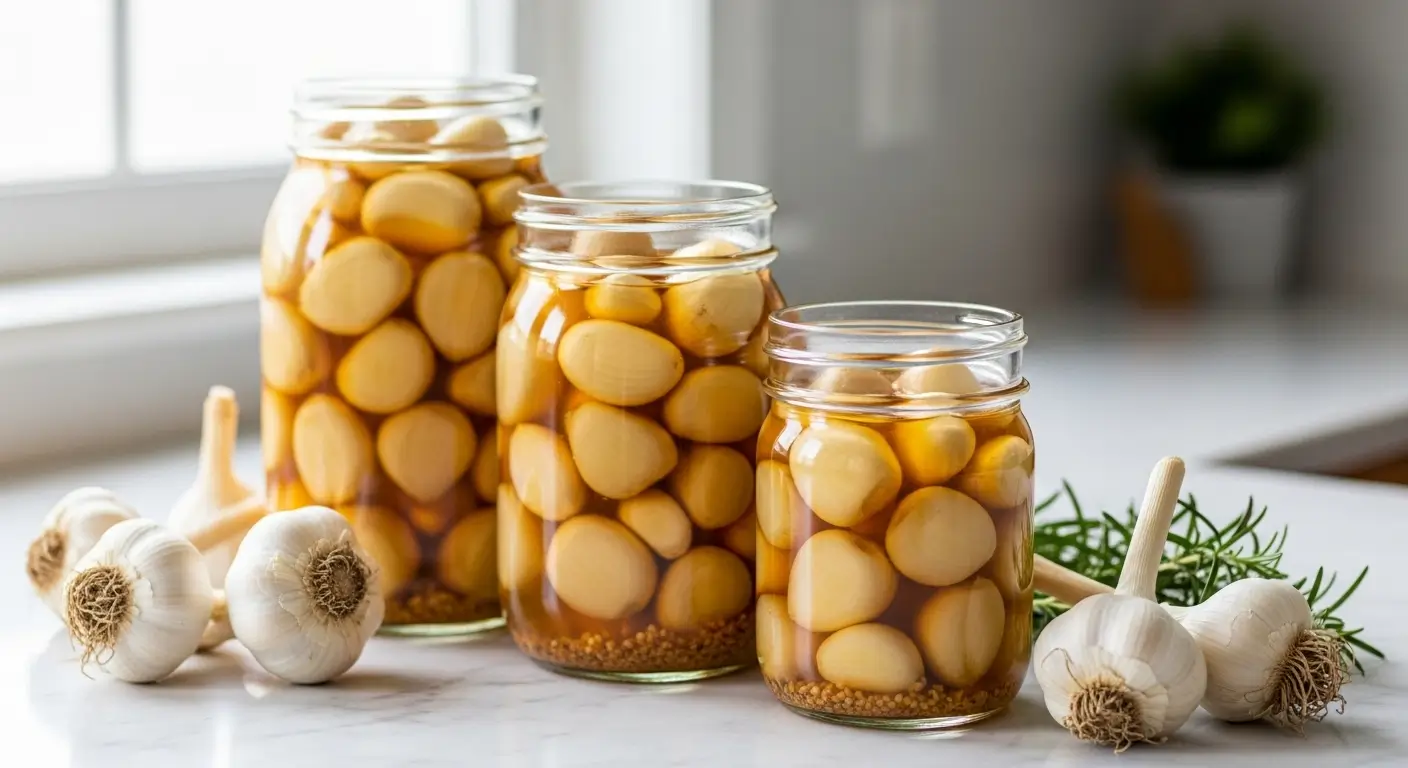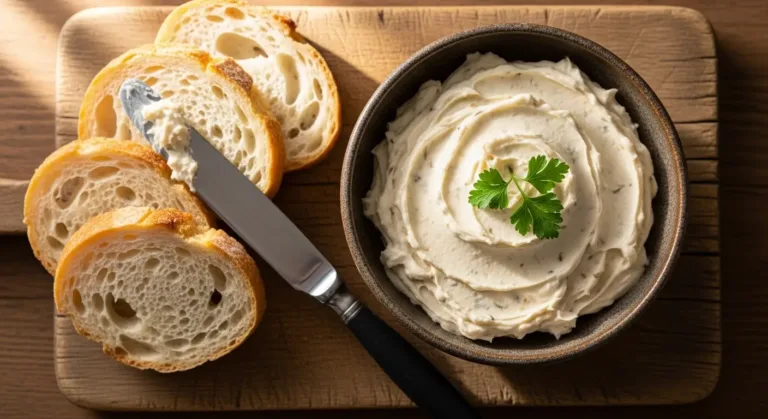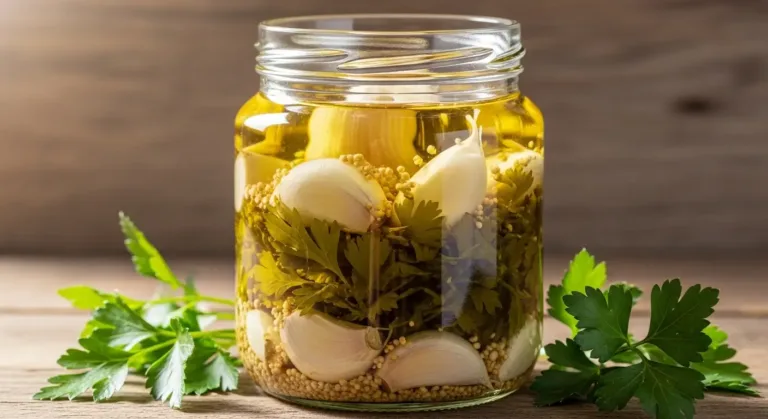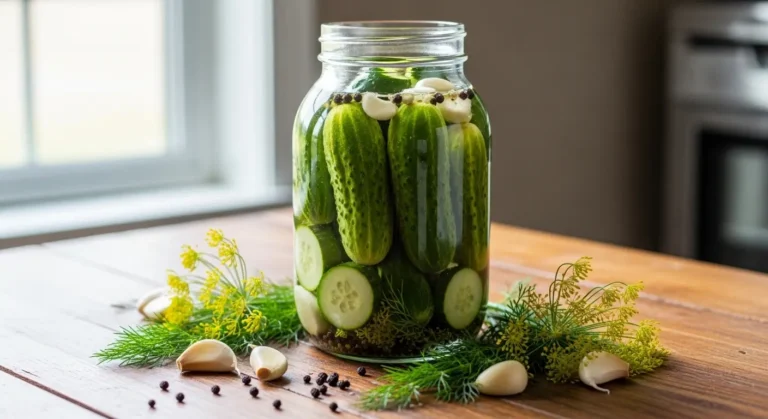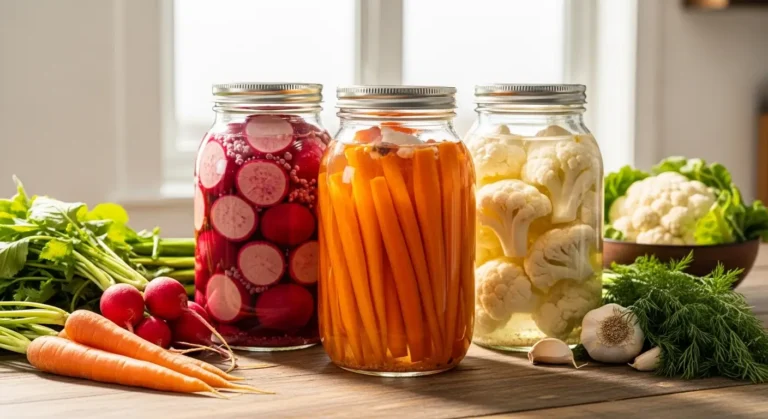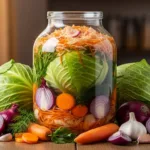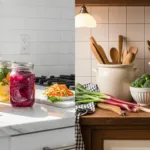So you’re into fermented garlic, huh? I get it—there’s something seriously cool about transforming regular garlic into this tangy, mellow powerhouse. But here’s the thing: Fermented Garlic Safety isn’t just some boring rulebook stuff. It’s actually super important if you want all that amazing flavor without, you know, any scary health issues. Whether you’re already obsessed with fermenting everything in sight or just thinking about giving fermented garlic a shot, I’m here to walk you through the whole deal. We’ll chat about the science (don’t worry, I’ll keep it simple), how to dodge botulism like a pro, what happens to allicin during fermentation, and some real-deal tips to make sure your homemade fermented garlic is both delicious and totally safe. Plus, I’ll show you how lactic acid becomes your best friend, share storage hacks, and help you figure out if something’s gone wrong before you take a bite. Learn more about safe fermentation with our guide to pickling vegetables.
What Is Fermented Garlic and How Does It Work?
How Garlic Fermentation Actually Happens
Okay, so fermentation is basically magic—but it’s actually just natural microbes doing their thing. You take some peeled garlic cloves, dunk them in saltwater brine, and let the good bacteria party while the bad guys get kicked out. The trick? No oxygen allowed. That’s what “anaerobic” means, and it’s key to getting the right microbes to do the work. What you end up with is garlic that tastes totally different—mellower, tangier—and it’s way easier on your stomach too.
Taste, Texture, and Health Benefits of Fermented Garlic
Fermented garlic is softer, milder, and honestly just more interesting than raw garlic. The fermentation process pumps up the probiotic content, which is great for your digestion and gut health. And instead of that sharp, punch-you-in-the-face garlic flavor, you get this complex, tangy vibe that’s perfect for dressings, dips, spreads—you name it. Learn more about health-focused garlic recipes on our fermented foods page.
Discover great ideas like: The Complete Guide to Vegetable Fermentation
Why Fermented Garlic Safety Is Important
Understanding the Real Risks (Botulism + Contamination)
Look, home fermentation is awesome and brings incredible flavors to your kitchen. But if you mess up the technique, things can get serious. The big bad guy here is Clostridium botulinum—yeah, the bacteria that causes botulism. This nasty organism loves low-acidity, oxygen-free environments, which is basically what happens if you don’t manage your garlic ferment properly. To keep botulism away, you’ve gotta control everything: how much salt you’re using, the temperature, how clean everything is, and the acidity level.
What the USDA & CDC Recommend for Safe Fermentation
The CDC and other food safety folks have put together some solid guidelines for safe home fermentation. Hitting the right pH targets (usually below 4.6), using squeaky-clean utensils, and making sure everything stays underwater in that brine—these aren’t optional. They’re essential. Don’t miss our guide to understanding food acidity for home cooks.
Botulism and Garlic: What You MUST Know
How Botulism Forms in Garlic Products
Botulism is rare, thank goodness, but it’s seriously dangerous. It’s caused by toxins from that Clostridium botulinum bacteria I mentioned. Symptoms? Think double vision, weak muscles, trouble swallowing, even paralysis. Not fun. The bacteria love oxygen-free, low-acid environments—which is exactly what poorly fermented garlic can become.
Garlic Confit vs Fermented Garlic — Which Is Riskier?
Whether you’re making garlic confit or fermented garlic, you’ve gotta be careful. Garlic confit usually sits in oil, which creates an oxygen-free zone that’s perfect for botulism if you don’t refrigerate it or add acid. With fermented garlic, you’re relying on lactic acid to stop toxin growth. Discover great ideas like our step-by-step guide to safe confit making.
Table: Botulism Risk Factors in Garlic Preparations
| Preparation Method | Key Risk | Prevention |
|---|---|---|
| Garlic in Oil (Confit) | Low-acid, anaerobic | Acidify, refrigerate |
| Fermented Garlic | Starter pH, hygiene | Monitor pH, use salt |
| Raw Garlic | None | Store properly |
Each preparation method requires specific Fermented Garlic Safety measures tailored to its unique risks.
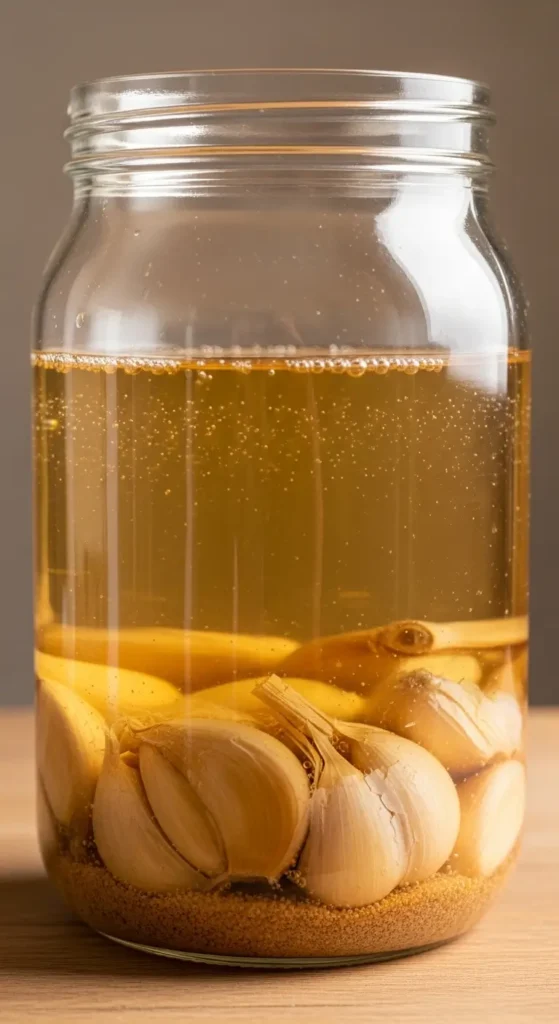
How to Ferment Garlic Safely (Step-by-Step Safety Method)
Correct Salt Percentage, Temperature & pH for Safe Fermentation
Getting the temperature and pH right is huge for safe fermented garlic. You want temps between 65–75°F. And that brine pH? It needs to drop below 4.6—grab some pH strips and check after a few days. If it’s still too high, either add more salt or be patient. The acidity will climb as the lactic acid bacteria do their work. Mastering these Fermented Garlic Safety fundamentals protects you from dangerous bacterial growth. Oh, and keep those cloves underwater in the brine at all times.
Maintaining Proper Hygiene for Safe Fermentation
Clean jars, clean utensils, clean hands—there’s no negotiating here. Skip the metal containers because they can react with acidic brine. Stick with glass or food-grade plastic instead. Before you start, sanitize everything with boiling water or a food-safe cleaner. And use fresh garlic bulbs without any damage or weird spots. These Fermented Garlic Safety practices create the foundation for successful fermentation every time.
The Role of Lactic Acid in Keeping Fermented Garlic Safe
How Lactic Acid Slows Harmful Bacteria
Lactic acid bacteria are seriously the superheroes of fermentation. As they take over the brine, they multiply like crazy and push the pH down to levels where nasty organisms—including Clostridium botulinum—can’t survive. Their metabolic activity is everything. This biological process is the cornerstone of Fermented Garlic Safety in home kitchens. Without enough of these good guys, toxin-producing bacteria might sneak in.
Learn more about: Stop Tossing That Sauerkraut Juice Down the Drain
Why Acidification Is the #1 Protection Against Botulism
Salt and the right temperature encourage lactic acid bacteria while shutting down pathogens. This creates rapid acidification, making it super hard for botulism to develop. That quick pH drop? That’s your number one safety guarantee for fermented garlic. Without understanding this aspect of Fermented Garlic Safety, you’re basically fermenting blind. Looking for inspiration? Try our recipe for lacto-fermented vegetables.
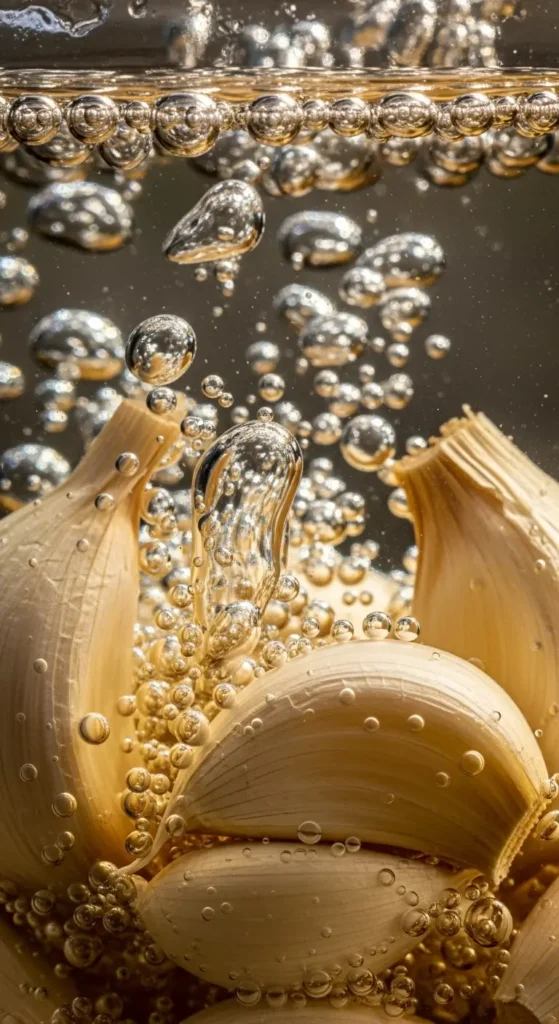
Does Fermented Garlic Still Contain Allicin?
What Happens to Allicin During Fermentation (Explained Simply)
Allicin is garlic’s superstar compound—it’s antimicrobial, antioxidant, and anti-inflammatory. But does fermentation destroy it? Studies show allicin does decrease over time because it converts to other sulfur compounds. Fermentation can hold onto some allicin, but you’ll have less than in raw garlic. Fermented Garlic Safety doesn’t mean sacrificing health benefits—it actually enhances some properties.
Raw, Fermented & Black Garlic — Comparing Compounds
Raw garlic has the most allicin, hands down. Black garlic (which is aged for weeks) and fermented garlic have less. But here’s the cool part: fermentation creates new bioactive compounds. So yeah, the profile changes, but the health benefits stick around. Don’t miss our deep dive into garlic’s active compounds.
Discover great ideas like: 7 Creative Kimchi Variations to Spice Up Your Meals
FAQs
Storage & Shelf Life of Fermented Garlic
Best Storage Containers and Conditions
Glass jars with airtight lids kept in your refrigerator are the safest bet. Write the date you started fermenting on the jar so you don’t forget. And don’t contaminate it—never dip into the jar with dirty utensils. Implementing Fermented Garlic Safety storage methods preserves both quality and safety for months.
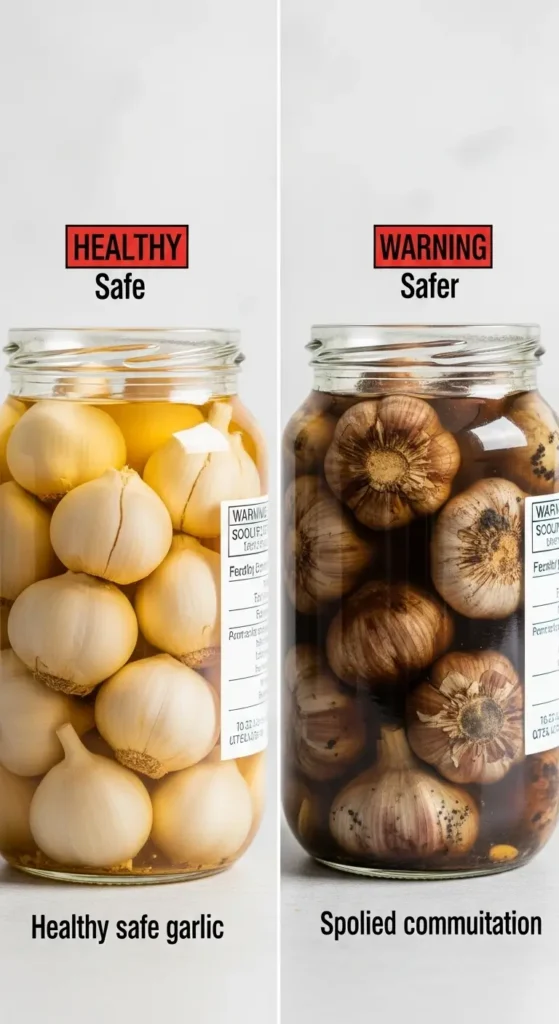
Warning Signs of Spoilage or Unsafe Fermentation
Toss your garlic if you see mold, it gets slimy, smells funky, or the color changes. Safety first, always. Part of Fermented Garlic Safety is knowing when something has gone wrong. If something seems questionable, just throw it out. Check out our visual guide to safe fermented foods.
Final Tips for Safe, Delicious Fermented Garlic
When you prioritize Fermented Garlic Safety, you’re opening up this whole world of flavor and health benefits for your kitchen. Keep your fermentation controlled, test that pH, and store things properly. Fermented Garlic Safety techniques are easy to master once you understand the core principles. Follow these tips and you’ll get to enjoy all the unique perks of flavorful, gut-friendly fermented garlic. Don’t miss our comprehensive guide to safe homemade condiments.
Print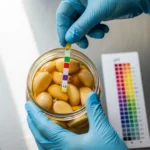
Fermented Garlic Safety: Detailed Guide for US Home Cooks
- Total Time: PT0M
- Yield: 1 jar 1x
- Diet: Vegan
Description
A simple, safe, and beginner-friendly way to make probiotic-rich fermented garlic using a 2% brine. Perfect for salads, sauces, spreads, or gut-friendly cooking.
Ingredients
- 10–15 garlic cloves, peeled
- 2% salt brine (2g salt per 100g water)
- Filtered or boiled-cooled water
- 1 small fermentation jar
- Optional: fermentation weight
Instructions
- Peel the garlic cloves and remove any bruised or damaged pieces.
- Mix a 2% brine by dissolving 2g salt per 100g of water.
- Place garlic cloves into a clean glass jar.
- Pour the brine over the garlic until fully submerged.
- Add a fermentation weight to keep cloves underwater.
- Close the jar loosely or use an airlock lid.
- Ferment at 65–75°F (18–23°C) for 1–4 weeks.
- Check the pH after a few days — target pH 4.2–4.6 or lower.
- Once the flavor is tangy and the pH is safe, refrigerate.
Notes
Store refrigerated for 3–6 months. Cloudiness, fizz, and color change are normal. Discard if mold, rotten smell, or sliminess appears.
- Prep Time: PT10M
- Cook Time: PT0M
- Category: Fermentation
- Method: Lacto-Fermentation
- Cuisine: American
Nutrition
- Serving Size: 1 clove
- Calories: 5
- Sugar: 0
- Sodium: 120
- Fat: 0
- Saturated Fat: 0
- Unsaturated Fat: 0
- Trans Fat: 0
- Carbohydrates: 1
- Fiber: 0
- Protein: 0
- Cholesterol: 0
Keywords: fermented garlic, lacto fermented garlic, garlic ferment, safe fermented garlic

